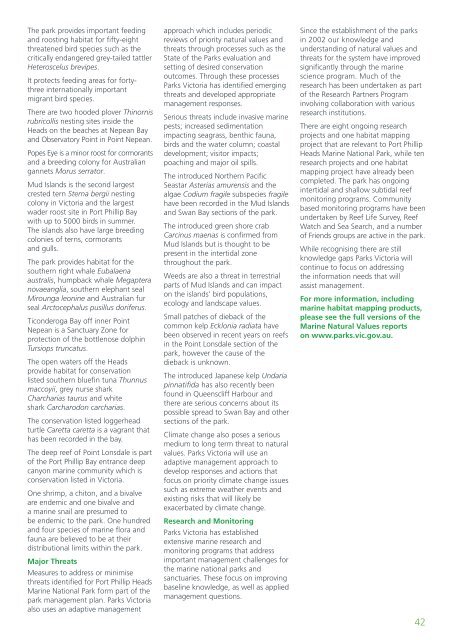Marine Natural Values Study Summary - Parks Victoria
Marine Natural Values Study Summary - Parks Victoria
Marine Natural Values Study Summary - Parks Victoria
You also want an ePaper? Increase the reach of your titles
YUMPU automatically turns print PDFs into web optimized ePapers that Google loves.
The park provides important feedingand roosting habitat for fifty-eightthreatened bird species such as thecritically endangered grey-tailed tattlerHeteroscelus brevipes.It protects feeding areas for fortythreeinternationally importantmigrant bird species.There are two hooded plover Thinornisrubricollis nesting sites inside theHeads on the beaches at Nepean Bayand Observatory Point in Point Nepean.Popes Eye is a minor roost for cormorantsand a breeding colony for Australiangannets Morus serrator.Mud Islands is the second largestcrested tern Sterna bergii nestingcolony in <strong>Victoria</strong> and the largestwader roost site in Port Phillip Baywith up to 5000 birds in summer.The islands also have large breedingcolonies of terns, cormorantsand gulls.The park provides habitat for thesouthern right whale Eubalaenaaustralis, humpback whale Megapteranovaeanglia, southern elephant sealMirounga leonine and Australian furseal Arctocephalus pusillus doriferus.Ticonderoga Bay off inner PointNepean is a Sanctuary Zone forprotection of the bottlenose dolphinTursiops truncatus.The open waters off the Headsprovide habitat for conservationlisted southern bluefin tuna Thunnusmaccoyii, grey nurse sharkCharcharias taurus and whiteshark Carcharodon carcharias.The conservation listed loggerheadturtle Caretta caretta is a vagrant thathas been recorded in the bay.The deep reef of Point Lonsdale is partof the Port Phillip Bay entrance deepcanyon marine community which isconservation listed in <strong>Victoria</strong>.One shrimp, a chiton, and a bivalveare endemic and one bivalve anda marine snail are presumed tobe endemic to the park. One hundredand four species of marine flora andfauna are believed to be at theirdistributional limits within the park.Major ThreatsMeasures to address or minimisethreats identified for Port Phillip Heads<strong>Marine</strong> National Park form part of thepark management plan. <strong>Parks</strong> <strong>Victoria</strong>also uses an adaptive managementapproach which includes periodicreviews of priority natural values andthreats through processes such as theState of the <strong>Parks</strong> evaluation andsetting of desired conservationoutcomes. Through these processes<strong>Parks</strong> <strong>Victoria</strong> has identified emergingthreats and developed appropriatemanagement responses.Serious threats include invasive marinepests; increased sedimentationimpacting seagrass, benthic fauna,birds and the water column; coastaldevelopment; visitor impacts;poaching and major oil spills.The introduced Northern PacificSeastar Asterias amurensis and thealgae Codium fragile subspecies fragilehave been recorded in the Mud Islandsand Swan Bay sections of the park.The introduced green shore crabCarcinus maenas is confirmed fromMud Islands but is thought to bepresent in the intertidal zonethroughout the park.Weeds are also a threat in terrestrialparts of Mud Islands and can impacton the islands’ bird populations,ecology and landscape values.Small patches of dieback of thecommon kelp Ecklonia radiata havebeen observed in recent years on reefsin the Point Lonsdale section of thepark, however the cause of thedieback is unknown.The introduced Japanese kelp Undariapinnatifida has also recently beenfound in Queenscliff Harbour andthere are serious concerns about itspossible spread to Swan Bay and othersections of the park.Climate change also poses a seriousmedium to long term threat to naturalvalues. <strong>Parks</strong> <strong>Victoria</strong> will use anadaptive management approach todevelop responses and actions thatfocus on priority climate change issuessuch as extreme weather events andexisting risks that will likely beexacerbated by climate change.Research and Monitoring<strong>Parks</strong> <strong>Victoria</strong> has establishedextensive marine research andmonitoring programs that addressimportant management challenges forthe marine national parks andsanctuaries. These focus on improvingbaseline knowledge, as well as appliedmanagement questions.Since the establishment of the parksin 2002 our knowledge andunderstanding of natural values andthreats for the system have improvedsignificantly through the marinescience program. Much of theresearch has been undertaken as partof the Research Partners Programinvolving collaboration with variousresearch institutions.There are eight ongoing researchprojects and one habitat mappingproject that are relevant to Port PhillipHeads <strong>Marine</strong> National Park, while tenresearch projects and one habitatmapping project have already beencompleted. The park has ongoingintertidal and shallow subtidal reefmonitoring programs. Communitybased monitoring programs have beenundertaken by Reef Life Survey, ReefWatch and Sea Search, and a numberof Friends groups are active in the park.While recognising there are stillknowledge gaps <strong>Parks</strong> <strong>Victoria</strong> willcontinue to focus on addressingthe information needs that willassist management.For more information, includingmarine habitat mapping products,please see the full versions of the<strong>Marine</strong> <strong>Natural</strong> <strong>Values</strong> reportson www.parks.vic.gov.au.42
















